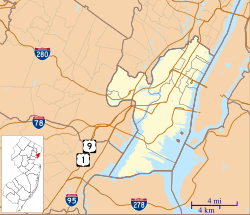Hamilton Park Historic District | |
 View to the south | |
| Location | Roughly bounded by Brunswick, Grove, 6th, and 9th Streets, Jersey City, New Jersey |
|---|---|
| Coordinates | 40°43′39″N74°2′42″W / 40.72750°N 74.04500°W |
| Area | 42 acres (17 ha) |
| Architectural style | Late Victorian |
| NRHP reference No. | 79001493 [1] |
| NJRHP No. | 1507 [2] |
| Significant dates | |
| Added to NRHP | January 25, 1979 |
| Designated NJRHP | April 27, 1978 |
Hamilton Park is a neighborhood in Historic Downtown Jersey City, Hudson County, in the U.S. state of New Jersey, centered on a park with the same name. Hamilton Park is located west of Newport, north of Harsimus Cove, north and east of The Village and south of Boyle Plaza. The Victorian age park is located between Eighth Street and Ninth Street and Hamilton Place on the west and McWilliams Place on the East. Like the Van Vorst Park neighborhood to the south, this quiet park is surrounded by nineteenth century brownstones. [3] The park underwent renovations completed in 2010. [4]



